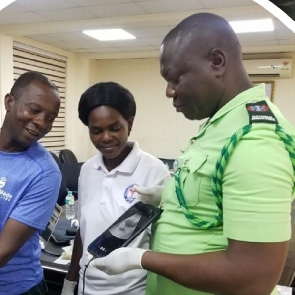 Senior ambulance staff demonstrating at the training
Senior ambulance staff demonstrating at the training
Advanced Emergency Medical Technicians, Batch 4 (Senior Officers) of the National Ambulance Service are set to graduate on June 22, 2023 after a successful 2 year training program at the Paramedic and Emergency Care Training School (PECTS), situated at Nkenkansu, in the Ashanti Region of Ghana.
PECTs has gained prominence over some years as one of the top pre-hospital medical training institutions in the country. It has over the years produced some of the finest Basic Emergency Medical Technicians and Advanced Emergency Medical Technicians with top notch skills and expertise in pre-hospital care that may be relevant and competitive in very developed parts of the world.
Indeed the saying 'your good name precedes you' is factual in the case of the National Ambulance Service, as Ethiopia among several other African countries have marveled at the quality of service provided by the Ghana National Ambulance Service(NAS).
NAS is consequently becoming a pacesetter in sub Saharan Africa. As of now, PECTs is the premier paramedic school in West Africa.
The National Ambulance Service which was formed in 2004, has seen unprecedented growth. It may be one of the youngest public institutions and yet one of the most thriving.
It has the potential to give Ghana high ratings and be as competitive as Japan is (the country with the best ambulance service globally) when given consistent and immense support.
Extensively, PECTs which is under the Ministry of Health, trains two categories of Emergency Medical Technicians (EMT). The Basic Emergency Medical Technicians and the Advanced Emergency Medical Technicians.
Basic EMT's have the knowledge and skills of Basic Life Support (BLS)
to stabilize and safely transport patients for all emergencies from life-threatening emergencies to routine transports. They render imperative and crucial pre-hospital treatment onsite and during the ambulance transport to the appropriate health facility or hospital for further management.
These include controlling bleeding, stabilizing breaks, and addressing shock. These services which are within the scope of practice of the Basic EMT are rendered with basic equipment typically found in an ambulance.
The Advanced Emergency Medical Technicians (AEMT): AEMTs are trained to provide the same services as the Basic EMT and more. It is within the scope of the Advanced Emergency Medical Technicians (Senior Officers) to perform interventions with the basic and advanced equipment typically found on an ambulance. The Advanced Emergency Medical Technician is a link from the scene to the emergency health care system with basic and advanced knowledge in pre-hospital care.
They have the skill and knowledge of Advance Life Support (ALS).
These skills include performing electrocardiographic rhythm interpretation of ventricular fibrillation, ventricular tachycardia, pulseless electrical activity and asystole. Perform cardiac defibrillation with the manual defibrillator; initiate peripheral intravenous (IV) lines in unconscious patients and maintain peripheral intravenous lines.
Upon their graduation, they will complement the efforts of the already hard working AEMTs and Basic EMTs on the field saving lives nationwide. Their service is crucial and an increase in their numbers is good news for the health landscape.